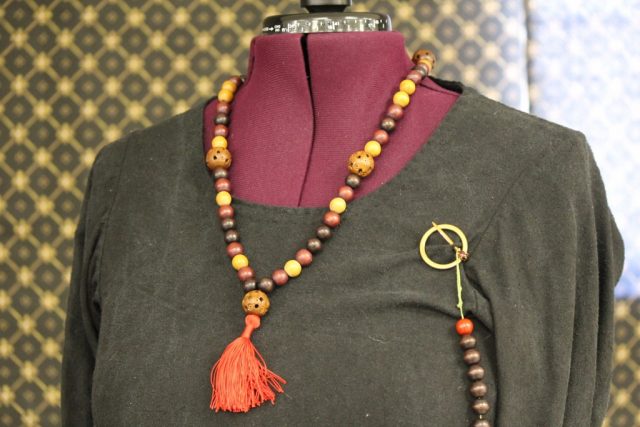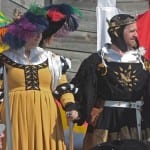Costuming

From the simplest tunics to the most amazing Renaissance ensembles, a love of medieval clothing runs throughout the Society!
 ‘What should I wear?’ is one of the very first questions from people experiencing the SCA for the first time. The short answer is a comfortable tunic (long enough to be a dress for ladies) and pants (a belt is optional). As a person new to the SCA, we understand that you can’t simply run down to your local store to purchase these items, but have no fear! You have options. One office in the local group is the Chatelaine (also called Hospitaller or Gold Key), who acts to welcome newcomers and to help you get started. One of their tasks is to maintain “loaner garb,” a trove of medieval-style clothing in various sizes which are available for loan until you can create your own wardrobe. Once you are properly outfitted, take advantage of your first few events to check out different styles of costuming. The SCA covers over a millenium of history and offers a wide variety of clothing promising to suit every taste and whim.
‘What should I wear?’ is one of the very first questions from people experiencing the SCA for the first time. The short answer is a comfortable tunic (long enough to be a dress for ladies) and pants (a belt is optional). As a person new to the SCA, we understand that you can’t simply run down to your local store to purchase these items, but have no fear! You have options. One office in the local group is the Chatelaine (also called Hospitaller or Gold Key), who acts to welcome newcomers and to help you get started. One of their tasks is to maintain “loaner garb,” a trove of medieval-style clothing in various sizes which are available for loan until you can create your own wardrobe. Once you are properly outfitted, take advantage of your first few events to check out different styles of costuming. The SCA covers over a millenium of history and offers a wide variety of clothing promising to suit every taste and whim.
 ‘How do I get that garment?’ is frequently the next question asked by newcomers. The short answer is, you buy it or you make it. The SCA features a number of talented and skillful costumers who take commissions as merchants and will sew garments for you should you wish. If you enjoy creating, you also have the option to learn costuming from any of the very skilled and talented costumers across the area. Their passion often inspires them to teach at events, at project nights, even one on one and frequently at no charge. Most basic garments require little effort if you have a sewing machine and can follow a line. There are also Costuming Guilds available, with the purpose of promoting costuming, teaching and advancing research. Every member of the Guild is happy to answer your questions and share their time and knowledge with you. They can guide you on what garments are appropriate for your chosen time period and location, help you with fabric choices, aid you in creating patterns as well as the technical skills needed for advanced costuming.
‘How do I get that garment?’ is frequently the next question asked by newcomers. The short answer is, you buy it or you make it. The SCA features a number of talented and skillful costumers who take commissions as merchants and will sew garments for you should you wish. If you enjoy creating, you also have the option to learn costuming from any of the very skilled and talented costumers across the area. Their passion often inspires them to teach at events, at project nights, even one on one and frequently at no charge. Most basic garments require little effort if you have a sewing machine and can follow a line. There are also Costuming Guilds available, with the purpose of promoting costuming, teaching and advancing research. Every member of the Guild is happy to answer your questions and share their time and knowledge with you. They can guide you on what garments are appropriate for your chosen time period and location, help you with fabric choices, aid you in creating patterns as well as the technical skills needed for advanced costuming.
 Within the SCA, costuming choices are as wide and varied as its members and there is something for every personal style. Whether your tastes lie with the simplicity of the Anglo-Saxon chiton of the tenth century or the fitted European cotehardie of the fourteenth century, with the Celtic knot work embroidered garments so popular in the Viking Age or the grandeur of sixteenth century Elizabethan fashion, you will most assuredly find a costumer who shares your passion and is willing to guide you. Costuming is one of the most effective vehicles to transport us visually from the modern to the medieval world and so costumers feel pride in creating wearable art that adds to the medieval ambience that is so enjoyed within the SCA.
Within the SCA, costuming choices are as wide and varied as its members and there is something for every personal style. Whether your tastes lie with the simplicity of the Anglo-Saxon chiton of the tenth century or the fitted European cotehardie of the fourteenth century, with the Celtic knot work embroidered garments so popular in the Viking Age or the grandeur of sixteenth century Elizabethan fashion, you will most assuredly find a costumer who shares your passion and is willing to guide you. Costuming is one of the most effective vehicles to transport us visually from the modern to the medieval world and so costumers feel pride in creating wearable art that adds to the medieval ambience that is so enjoyed within the SCA.
If you’re interested in learning more about costuming, contact the Arts and Sciences Officer of your nearest branch to find out when and where classes and workshops are held!
